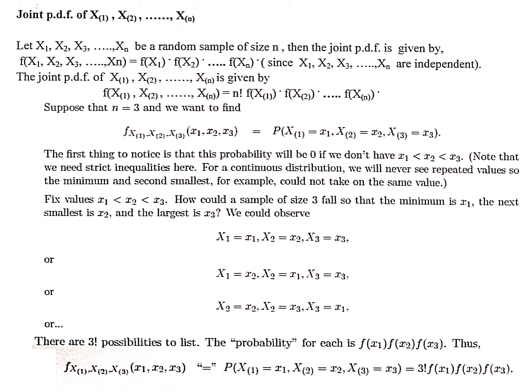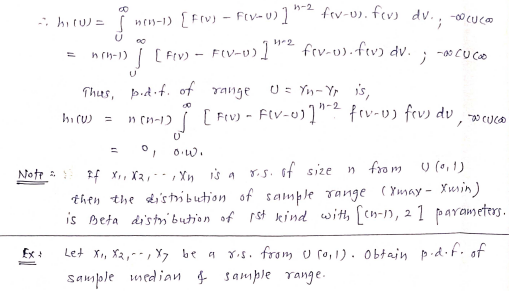Order Statistics
B.Sc.
III Semester- VI
Statistics –XIII
Probability
Theory and Applications
Unit 1: Order Statistics and Convergence
1.1 Order Statistics
Let X1, X2, X3,
…..,Xn be a random sample of
size n from a continuous distribution with p. d. f. f(x) and c .d. f. F(x).
Let,
X(1) = min { X1, X2, X3,
….., Xn }
X(2) =
2nd min { X1, X2, X3, ….., Xn
}
X(3) =
3rd min { X1, X2, X3, ….., Xn
}
…..
X(n) =
nth min { X1, X2, X3, ….., Xn } = max{ X1, X2, X3,
….., Xn }
then
X(1) , X(2) , ……, X(n) are known as the order statistics corresponding
to the random sample X1, X2, X3, …..,Xn.
For convenience, we denote Y1 =
X(1) , Y2 = X(2) , Y3 = X(3)
,….., Yn = X(n) . Thus Y1, Y2,
Y3,…..,Yn are the
order statistics corresponding to the random sample X1, X2,
X3, ….., Xn.
Note
that X(1) < X(2)
<……< X(n) i.e. Y1< Y2<
Y3,…..<Yn .
Note: Let X1, X2, X3, X4, X5 be i. i. d. random variables with a distribution F with a range of (a, b). We can relabel these X’s such that their labels correspond to arranging them in increasing order so that X(1) ≤ X(2) ≤ X(3) ≤ X(4) ≤ X(5) .
X(1)
X(2) X(3) X(4) X(5)
a X5 X1 X4 X2 X3 b
In the case where the
distribution F is continuous we can make the stronger statement that X(1)
< X(2) < X(3) < X(4) < X(5)
Since P(Xi = Xj) = 0 for all i ≠
Distribution of 1st order statistics Y1 i.e. X(1) or Xmin
Let X1, X2, X3, …..,Xn be a random sample of size n from a continuous distribution with p. d. f. f(x) and c .d. f. F(x). Let Y1 = min { X1, X2, X3, ….., Xn } i.e. Y1 is first order statistics corresponding to the random sample X1, X2, X3, …..,Xn.
Let g1(y) be the p. d. f. and G1(y) is a c. d. f. of Y1.
By defn of c. d. f., we have
G1(y) = P [Y1 ≤ y] = P [min {X1, X2, X3, ….., Xn } ≤ y ]
= 1- P [min {X1, X2, X3, ….., Xn
} > y ]
= 1 - P [each of Xi’s > y ]
= 1- P [X1 > y, X2 > y, …, Xn > y]
= 1- P [X1> y] . P[ X2 >y]…… P[ Xn >y].
= 1-
= 1- ∏ [1- P (Xk ≤ y)]
G1(y) = 1-∏ [1- F (y)]
g1(y) =d/dy
= 0 – n [1- F (y)]n-1 [-f(y)]
Ex:
Let X1, X2, X3, …..,Xn be a random sample from U(0,1). Obtain p. d. f.
of first order statistics X(1) and hence find E(X(1) )
.
Soln
: Here X has uniform distribution i.e. X
̴ U (0,1) , the p. d. f. of X is
given by
f(x) = 1, 0 ≤ X ≤ 1
= 0,
otherwise
Here X1, X2, X3,
…..,Xn is a random sample
from U(0,1).
Let, Y1 = X(1) = min { X1, X2, X3,
….., Xn }.
We have c. d. f. of X is, F(x) = P[X ≤ x] = ∫
g1(y) = n [1- F (y)]n-1 [f(y)]
= n
[1-
y1]n-1 . 1
= 0, otherwise
This
is p. d. f. of beta distribution of first kind with parameters (1,n).
i.
e. Y1 ̴ β
Now,
E [X(1)]
= E [Y1]
= ∫ y1
g1(y) dy =
= n
=
n β1 (2, n) =
Distribution of nth
order
statistics Yn i.e.
X(n) or X max
Let X1, X2, X3, …..,Xn be a random sample of size n from a continuous distribution with p. d. f. f(x) and c .d. f. F(x). Y1, Y2, Y3,…..,Yn are the order statistics corresponding to the random sample X1, X2, X3, ….., Xn. Here Yn = max { X1, X2, X3, ….., Xn } = X max .
Let gn (y) be
the p. d. f. and Gn(y) is a c. d. f. of Yn.
By defn of
c. d. f., we have
Gn(y) = P [Yn ≤ y] = P [max {X1, X2, X3, ….., Xn } ≤ y ]
= P [each of Xi’
s ≤ y ]
= P [X1 ≤ y, X2 ≤ y,…… ,Xn ≤ y].
= P [X1 ≤ y] . P[ X2 ≤ y]…… P[ Xn ≤ y].
= ∏ P [Xk ≤ y]
= ∏ F (y)
Gn(y) =
∴
gn(y) =d/dy
∴ gn(y) = n [ F (y)]n-1 [f(y)]
Ex:
Let X1, X2, X3, …..,Xn be a random sample from U(0,1). Obtain p. d. f.
of maximum( nth order statistics X(n) ) .
Soln
: Here X has uniform distribution i.e. X
̴ U (0,1) , the p. d. f. of X is
given by
f(x) = 1, 0 ≤ X ≤ 1
= 0,
otherwise
Here X1, X2, X3,
…..,Xn is a random sample
from U(0,1).
Let, Yn = X(n) = max { X1, X2, X3,
….., Xn }.
We have c. d. f. of X is, F(x) = P[X ≤ x] = ∫ f(t) dt = ∫ 1 dt = [t] (0 to x) = x ; 0 ≤ x ≤ 1.
Gn(y) = n [ F (y)]n-1 [f(y)]
= n
[
yn]n-1 . 1
= 0, otherwise
This
is p.d.f. of beta distribution of first kind with parameters (n,1).
i. e. Yn ̴ β1 (n,1).
Note:
If
X1, X2, X3, …..,Xn be a random sample from U(0,1), then
i) Y1 = min { X1, X2, X3, ….., Xn } ̴ β1 ( 1,n).
ii) Yn = max { X1, X2, X3, ….., Xn } ̴ β1 ( n,1).
***

J Joint p. d. f. of ith and jth order statistics:





















Comments
Post a Comment